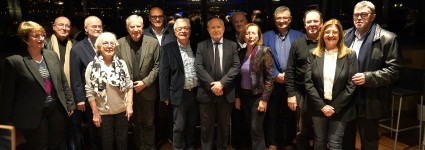Koen De Ridder, Professor at Flemish Institute of Technological Research (VITO) Belgium, warned that heat stress will skyrocket by the end of the century,at his conference on November 15th . The conference was part of the Re-city platform's "Facing Climate Change" series, organized by the Catalonia Europe Foundation in collaboration with BBVA and supported by the Barcelona City Council, the Metropolitan Area of Barcelona and the Department of "Territori i Sostenibilitat" of Generalitat de Catalunya. The conference was moderated by Xavier Rodó, ICREA researcher, head of the Climate and Health research program of ISGlobal, and ReCity's "Facing Climate Change" cycle scientific advisor.
De Ridder, an expert in urban climate and air quality,developed the UrbClim model at the VITO Institute. This is one of the few climate models offering detailed local level information on factors such as climate, temperature, pollution, extreme weather changes and so-called heat islands in cities (Urban Heat Island, UHI). These islands have temperatures up to 10ºC higher than the rural environment, directly affecting the health and well-being of citizens. Most other models only offer macro data at the regional or global level.
The model is part of a European program that produces climate simulations in 100 European cities, explaining microclimatic effects. Simulations have been carried out with a high degree of certainty in cities such as Barcelona, Paris, London, Berlin, Athens and Brussels, following UN Intergovernmental Panel on Climate Change (IPCC) scenarios up to the end of the 21st century. In Barcelona and its metropolitan area, this research is carried out by Xavier Rodó's team at the Global Health Institute of Barcelona (ISGlobal). It takes into account indicators such as temperature, rainfall, number of hot days, air pollution, energy and transport, forest fires, heat-related diseases and aquatic ecosystems, among many others.
According to these studies, urban heat islands can cause higher mortality rates, higher hospital admissions, more premature births, less economic and labor productivity, infrastructure damage and an increase in energy consumption. Koen De Ridder warned that episodes of extreme heat will multiply by ten in European cities by the end of the century. Currently, heat islands in cities represent significant differences in temperature in relation to rural environments. For example, in Paris the temperature in the heat islands is 5 degrees higher than its surroundings, and in the case of Barcelona the difference is between 1.5 and 3 degrees higher. Heat islands primarily occur at night and in cities with greater population densities. For this reason, cities on average have twice as many days of extreme heat as their rural surroundings.
In France, the VITO Institute's studies calculated a 140% increase in mortality during the strong heat wave of 2003, part of approximately 70,000 deaths in Europe resulting from extreme heat. De Ridder proposes ian increase in green infrastructure and green zones that can help to cool cities and avoid exceeding heat thresholds, beyond which people's health and well-being is at risk. These proposals will require a strong political commitment from governments.










